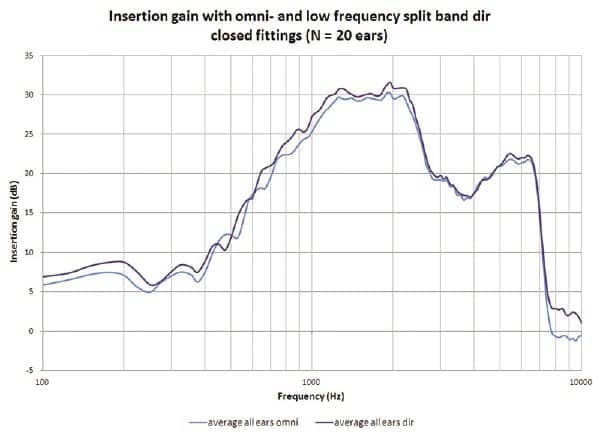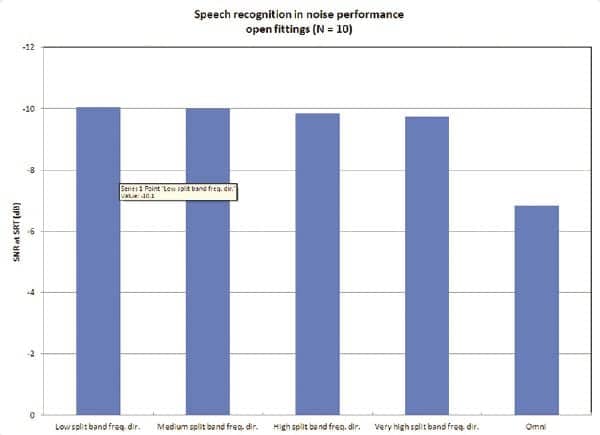By Kimi Møller, MA, and Charlotte Jespersen, MA
One of the most common complaints of hearing aid users with sensorineural hearing impairment is speech understanding in noisy surroundings, and this often continues to be a complaint after the provision of hearing aids. Hearing-impaired individuals require a better signal-to-noise ratio (SNR) than normal-hearing individuals for the same speech recognition. The use of directionality is a well-established way to improve SNR.
Directional microphones are less sensitive in low-frequency regions than omnidirectional microphones due to similar phase relationships between front and rear microphones for low-frequency sounds. This can result in a loss of audibility for low-frequency sounds and a noticeable change in loudness and sound quality when activating the directional response from an omnidirectional setting. To resolve this problem, a boost in low-frequency amplification is traditionally applied. The bass boost compensation is used to counter loss of far-field low-frequency sounds caused by a directional microphone. However, that compensation leads to over-amplification of near-field sounds (ie, the proximity effect). The noise floor in the hearing aid is increased, which may mask other sounds1 and be very annoying for the hearing aid user. This noise perception is noticeable mainly in quiet environments, and is typically reported by hearing aid users who have minimal hearing loss in the low frequencies.

|
| Figure 1. ReSound Verso and Alera RIEs feature bandsplit directional processing. |
To circumvent issues with conventional, full-band directionality, ReSound uses bandsplit directional processing, in which incoming signals are processed based on their frequency content. High frequencies are processed as a directional response, while low frequencies are processed as an omnidirectional response. The frequency at which the processing of the input signal changes between omnidirectional and directional is called the “bandsplit frequency.” The bandsplit frequency is automatically calculated for ReSound hearing instruments in the fitting software, and is based on the individual’s low-frequency hearing thresholds and the hearing aid model fitted. There are four bandsplit frequency settings for each dual microphone hearing instrument style.
The purpose of bandsplit directionality as implemented in ReSound hearing instruments is to provide directional benefit without the sound quality drawbacks of directionality. The lack of sound quality differences between directional and omnidirectional responses allows for transparent microphone mode switching, as well as applying asymmetric directional fitting strategies. Groth et al2 found that bandsplit directionality was preferred to full-band directionality in terms of sound quality, and was not distinguishable from an omnidirectional response. An additional advantage of bandsplit directionality in hearing aids with behind-the-ear (BTE) microphone placement is that it approximates the natural directivity patterns of the open ear, thereby helping to preserve horizontal localization.3
To our knowledge, no studies have looked into the effect of changing the bandsplit frequency in terms of balancing sound quality and SNR benefit. We were interested in validating the speech intelligibility improvement with bandsplit directionality compared to omnidirectional processing, as well as the impact of changing the bandsplit frequency.
Because the potential for directional benefit differs for open versus occluding fittings, we found it clinically relevant to also look into whether differences exist between open and occluding fittings separately. Sound quality ratings for omnidirectional and directional settings were also obtained to confirm earlier results showing that bandsplit directional and omnidirectional provide similar sound quality.
Methods
A total of 20 participants with bilateral sensorineural hearing loss participated in this study. Half (10) were fitted with ReSound Alera 977 BTE hearing aids with domes, and half (10) were fitted with closed Alera 977 BTE hearing aids, using the individuals’ own earmolds. Programming for each participant’s hearing loss was achieved through Aventa 3.3, using the Audiogram+ fitting rule with the “experienced non-linear” profile. Aside from feedback management, all other special signal processing algorithms in the hearing aids were turned off. Gain was adjusted in each program according to the user’s preference, and was set identically for the omnidirectional and directional program.
Real-ear insertion gain was measured with a 65 dB SPL speech-weighted noise stimulus presented at 0° azimuth for both the omnidirectional and fixed directional programs. The lowest bandsplit frequency was selected for the directional program, to result in the highest degree of directional processing.
Speech-in-noise testing with 5 different hearing aid microphone response settings was performed using a Danish sentence test in noise, the Dantale II test, which is an adaptive test that determines the SNR at the listener’s speech reception threshold.4 The 5 test conditions included omnidirectional and four bandsplit settings of fixed directionality: “high,” “medium,” “low” and “very low.” The testing order and sentence lists for the five conditions were counterbalanced across subjects.

|
| Table 1. Conditions tested for noisiness comparisons. |
Test participants also completed two-alternative forced-choice “noisiness” comparisons among 3 conditions, outlined in Table 1. In each condition, the subject was seated in a quiet soundbooth and asked to determine which condition had the highest degree of noise. The order of conditions was counterbalanced across subjects.
Results and Discussion
Real ear insertion gain. Figure 2 compares the Real Ear Insertion Gains for the omnidirectional and directional programs for the open fit and occluded fit conditions. An excellent match between omnidirectional and directional was attained for each condition. This indicates that low-frequency audibility was preserved in the directional program, thereby ruling out the risk of insertion gain differences being a possible reason for differences in speech intelligibility in noise.
SNR benefit. There were significant differences among all the tested settings on the speech-in-noise scores. All directional program options were significantly better (p < 0.01) than the omnidirectional program (Figure 3). Consistent with expectations, the results were slightly different for the group of participants with open fittings than the group with occluding fittings. For the open-fit group, the maximum SNR improvement compared to the omnidirectional response was 3 dB, and was observed for the lowest bandsplit frequency. However, there were no significant differences among the different directional conditions. This was an expected finding, as the open fitting allows low frequency sound to enter the ear canal that will be audible to individuals with mild hearing level thresholds in the low frequencies. This naturally limits the potential directional benefit that can be provided in the low frequencies, and is consistent with other reports of directional benefit in open-fit hearing aids.5,6
For the participants with occluding fittings, increasingly lower bandsplit frequency settings yielded better speech-in-noise testing scores (p < 0.01). The greatest increase in SNR benefit was 4 dB, and was observed between omnidirectional and the lowest bandsplit frequency directional setting.
These findings support that providing directionality in the frequency area with the most crucial speech information makes the biggest difference in SNR improvement. Extending bandwidth across which directionality is applied to lower frequencies adds additional incremental benefit for fittings which are occluding.
“Noisiness” test. Results of the forced-choice noisiness test revealed no significant differences among the different conditions for either the open-fit or the occluding-fit groups. We expected that the condition with the lowest bandsplit frequency would be found to be significantly noisier than the omnidirectional condition, but this did not prove to be the case. Results of this test are consistent with the Groth et al2 study, in which listeners showed an equal preference for both bandsplit directional and omnidirectional processing.
Fitting Bandsplit Directionality
In the ReSound Aventa fitting software, the bandsplit frequency is represented by the Directional Mix setting, which indicates the amount of directionality in the processed signal. Directional Mix levels are inversely proportional to the bandsplit frequency level; the higher Directional Mix level, the lower the bandsplit frequency. Therefore, a high Directional Mix setting provides a high degree of directionality. When fine tuning the hearing aid, the professional has the flexibility to select from four levels of Directional Mix corresponding to four different bandsplit frequency settings. Aventa automatically calculates a prescribed Directional Mix level for each individual’s hearing loss and hearing aid model to achieve the optimum balance between sound quality and directional benefit. The hearing care professional might opt to change the Directional Mix setting to a higher level (ie, a lower bandsplit frequency) if the user reports limited benefit in noise in the directional program.
Summary
The results of this study indicate that bandsplit directionality achieves three goals. First, it provides SNR improvement compared to an omnidirectional response regardless of the bandsplit frequency setting, and for both open and occluding fittings. Second, it gives the same degree of audibility for the directional program as for the omnidirectional program. Third, the bandsplit directional processing provides equivalent sound quality to an omnidirectional response.
Bandsplit directional technology is critical for the success of algorithms that automatically switch among microphone modes. Without it, hearing instrument wearers may be sensitive to sound quality differences between microphone modes. These differences in sound quality can be distracting at best, and can take the hearing instrument wearer’s focus from the benefits of amplification and directionality. In other words, wearers might find themselves noticing that the hearing aid is changing the sound (perhaps in an annoying way) rather than just being able to hear clearly without the hearing aid processing calling attention to itself.

|

|
Kimi Møller, MA, is an audiologist in charge of clinical trials, and Charlotte Jespersen, MA, is director of audiology development at GN ReSound AS in Ballerup, Denmark. CORRESPONDENCE to Kimi Moeller, MA, at: [email protected] |
References
1. Ricketts T, Henry P. Low-frequency gain compensation in directional hearing aids. J Am Acad Audiol. 2002;11:29-41.
2. Groth J, Laureyns M, Piskosz M. Double-blind study indicates sound quality preference for Surround Sound Processor. Hearing Review. 2010;17(3):273-284.
3. Van den Bogaert T, Carette E, Wouters J. Sound source localization using hearing aids with microphones placed behind-the-ear, in-the-canal, and in-the-pinna. Int J Audiol. 2011;50(3):164-176.
4. Wagener K, Josvassen JL, Ardenkjær R. Design, optimization, and evaluation of a Danish sentence test in noise. Int J Audiol. 2003;42(1):10-17.
5. Magnusson L, Claesson A, Persson M, Tengstrand T. Speech recognition in noise using bilateral open fit hearing aids: the limited benefit of directional microphones and noise reduction. Int J Audiol. 2013;52(1):29-36.
6. Valente M, Mispagel KM. Unaided and aided performance with a directional open-fit hearing aid. Int J Audiol. 2008;47:329-336.









